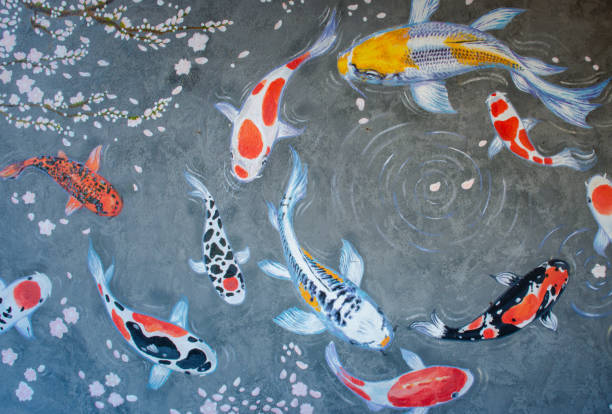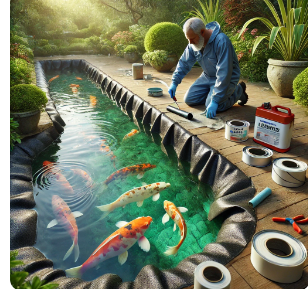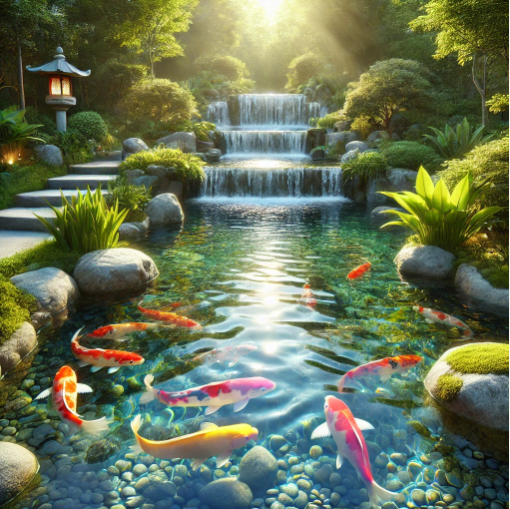Koi fish are more than just beautiful pond dwellers—they are living art. Caring for koi properly ensures they grow healthy, live long, and display vibrant colors. Whether you’re a beginner or an experienced koi keeper, understanding their care is essential.
This guide covers pond setup, water quality, feeding, seasonal care, and common health issues to help you keep your koi happy and thriving.
1. Setting Up the Perfect Koi Pond
A proper pond setup is the foundation of good koi care. The right environment ensures healthy growth, clear water, and a stress-free life for your fish.
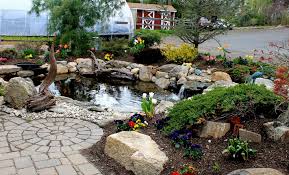
Pond Size & Depth
✔ Minimum 1,000 gallons (larger is better)
✔ Depth of 3-4 feet to protect against predators and temperature swings
✔ Larger ponds support more fish and better water stability
🔹 Pro Tip: The more koi you have, the bigger your pond should be to avoid overcrowding.
Filtration & Aeration
✔ Use a high-quality filtration system to remove waste and keep water clean
✔ Aerate the pond with air pumps or waterfalls to maintain oxygen levels
✔ Install a UV clarifier to reduce algae growth
🔹 Pro Tip: A biological filter helps beneficial bacteria break down harmful toxins like ammonia.
Water Quality Management
✔ Keep pH between 7.0 and 8.5
✔ Ammonia and nitrite levels should always be zero
✔ Nitrate should be below 40 ppm
✔ Regularly test water with a pond test kit
🔹 Pro Tip: Perform a 10-20% water change weekly to keep water parameters stable.
2. Feeding Your Koi Fish
Feeding koi the right food in the right amount keeps them healthy, enhances their colors, and prevents pond pollution.
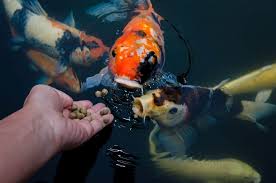
What to Feed Koi?
✔ High-quality koi pellets with 30-40% protein
✔ Color-enhancing foods like spirulina and shrimp meal
✔ Treats: Oranges, lettuce, watermelon, peas
✔ Avoid: Bread, processed foods, too much corn
🔹 Pro Tip: Feed only what they can eat in 3-5 minutes to prevent overfeeding and water pollution.
Feeding Frequency by Temperature
✔ Above 70°F (21°C) – 2-4 times daily (high-protein food)
✔ 60-70°F (15-21°C) – Once or twice daily
✔ 50-60°F (10-15°C) – Every 1-2 days (easily digestible food)
✔ Below 50°F (10°C) – Stop feeding (koi’s metabolism slows)
🔹 Pro Tip: Use a wheat germ-based food in colder months for easy digestion.
3. Seasonal Koi Fish Care
Koi ponds change with the seasons, and so should your care routine.
Spring (Warming Up)
✔ Slowly start feeding as water warms above 50°F (10°C)
✔ Test water parameters weekly
✔ Perform a thorough pond clean-up
Summer (Active Growth)
✔ Increase feeding with high-protein food
✔ Keep oxygen levels high with aeration
✔ Watch for overheating in shallow ponds
Fall (Preparing for Winter)
✔ Reduce feeding as temperatures drop
✔ Switch to wheat germ food
✔ Remove fallen leaves and debris from the pond
Winter (Dormant Period)
✔ Stop feeding below 50°F (10°C)
✔ Keep a pond heater or aerator running to prevent ice buildup
✔ Avoid breaking ice—it can stress the fish
🔹 Pro Tip: Never feed koi in freezing temperatures—their digestion slows, and uneaten food rots in the pond.
4. Common Koi Fish Health Issues
Koi are hardy, but they can develop diseases if water conditions or diet are poor.
Signs of a Sick Koi
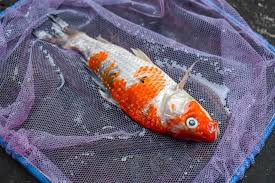
✔ Lethargy or floating oddly
✔ Loss of appetite
✔ Flashing (rubbing against pond walls)
✔ White spots or ulcers
Common Koi Diseases & Treatments
| Disease | Symptoms | Treatment |
| Ich (White Spot Disease) | Small white spots on body | Salt bath, increase water temp |
| Fin Rot | Frayed fins, redness | Antibiotic treatment |
| Swim Bladder Disorder | Floating upside down | Adjust diet, avoid overfeeding |
| Flukes (Parasites) | Scratching against pond walls | Anti-parasite treatment |
🔹 Pro Tip: Quarantine new koi for at least 2 weeks before adding them to the main pond.
5. Protecting Koi from Predators
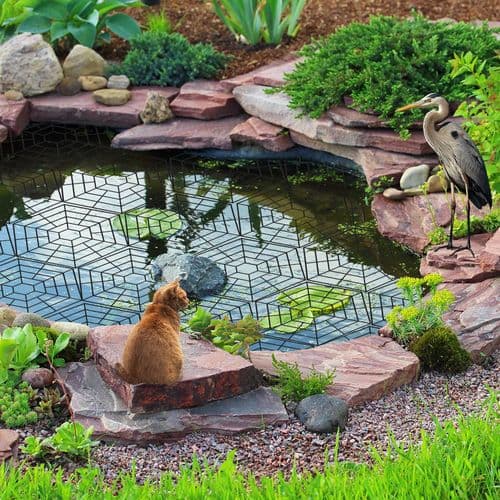
Predators like herons, raccoons, and cats can harm koi fish. Use these tips to protect them:
✔ Pond netting or floating plants provide cover
✔ Motion-activated sprinklers scare away birds
✔ Deeper pond areas prevent easy access for raccoons
🔹 Pro Tip: Adding koi caves or hiding spots gives fish a safe retreat.
Final Thoughts
Koi fish care requires attention to pond setup, water quality, feeding, and seasonal maintenance. By following these best practices, you’ll create a healthy, thriving koi pond for years to come.
Key Takeaways:
✔ Keep pond well-filtered and oxygenated
✔ Feed high-quality food based on temperature
✔ Perform regular water testing & maintenance
✔ Watch for signs of illness and treat early
✔ Protect koi from predators with covers and deep water zones
By staying consistent with your care routine, your koi fish will flourish, display stunning colors, and live a long, happy life!
📌 Do you have koi fish? Share your best care tips in the comments! 🐠💦

